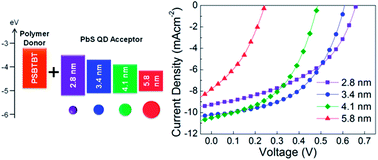Broadband-absorbing hybrid solar cells with efficiency greater than 3% based on a bulk heterojunction of PbS quantum dots and a low-bandgap polymer
Abstract
Currently existing common conjugated polymer:PbS quantum dot (QD)-based hybrid bulk heterojunction (BHJ) solar cells show efficiencies of less than 1% owing to improper bandgap alignment and poor coupling at the hybrid material interfaces. However, herein we report that PbS QD-based hybrid BHJ solar cells provide greatly increased efficiencies of more than 3%, which is attributed to the employment of a new kind of donor polymer poly[2,6-(4,4′-bis(2-ethylhexyl)dithieno[3,2-b:2′,3′-d]silole)-alt-4,7(2,1,3-benzothiadiazole) (PSBTBT), the optimization of donor–acceptor (D–A) band-offsets by strategically changing the diameter of PbS QDs in the donor matrix, and the modification of hybrid material interfaces via a chemical treatment of ligands around the QD surface. The optimized hybrid nanocomposite device performs well in good combination between the low-bandgap polymer and near-infrared (NIR)-absorbing PbS QDs, and it enables a broad spectral response from UV to NIR under an energetically favorable type-II heterojunction system, leading to high efficiencies of up to 3.48% under an air mass 1.5G illumination. The efficiency is higher than 3.39%, which corresponds to the efficiency value for the purely organic device fabricated in this study by utilizing [6,6]-phenyl-C71-butyric acid methyl ester (PCBM), which is the most widely studied electron acceptor in BHJ systems. These findings suggest that our hybrid BHJ blends are very promising, not only for use as energy conversion platforms to substitute all-organic or all-inorganic systems, but also for optoelectronic devices that require a broad spectral reaction.


 Please wait while we load your content...
Please wait while we load your content...